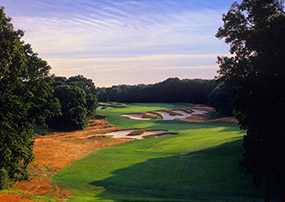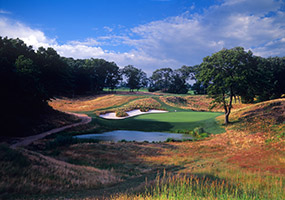Built during the heart of the Great Depression, the Bethpage State Park was a remarkably ambitious municipal golf development spread across almost 1,500 acres of woodland in central Long Island. The vision behind the park was Robert Moses, the influential president of the Long Island Parks Commission who spent much of his tenure acquiring land on the island for recreational pursuits. During the early 1930s his commission purchased the vast Bethpage estate in the village of Farmingdale, and set about transforming it into a first-class golf facility for New York residents. Architect A.W. Tillinghast was hired to design three new courses for the property and to modify an existing Devereaux Emmet layout.
Tillinghast’s courses were constructed by park superintendent Joseph Burbeck, and each was named after a color according to the skill level it best suited. Opening in 1936, the Black Course was designed from the outset to be the fiercest test at Bethpage and was given its share of the best land on site. Built on a sandy base, the holes are routed across a combination of broad, open slopes and more dramatic forested hills. The design focuses heavily on difficulty, particularly from the tee where you are either hitting through thick roughs to narrow slices of fairway, or flirting with spectacular sand hazards that protrude strategically into the holes. The putting shapes are less terrifying than at other Tillinghast courses, but getting onto the greens here is more complicated as many are steeply elevated or protected by deep greenside bunkers that are difficult to escape.
Given its length, forced carries and gruelling hazards, Bethpage Black is the sort of course that can easily overwhelm a golfer not quite on his form. Thankfully the opening few holes aren’t overly taxing, in fact the 1st green is one of the few here that will accept a well-judged bouncing approach from those good enough to hit its slender fairway. The rest of the front nine is not so forgiving, although there are still rewards for strong and sensible play. The 4th, for instance, is a world-class three-shotter that first bends around a cavernous sand trap before rising across a pair of bunkered ledges. Fours can be made on this hole, but taking an aggressive driving line close to the first bunker is the only way to get on or near the green in two. The next is an intimidating par four played through a twisted valley, the hole favoring a sliced drive partly across a sprawling diagonal bunker followed by a precise uphill approach shot into a small green that rests atop a plateau. The strategic use of an oblique waste hazard on the par five 7th is also very impressive, as is the short cross-pond 8th, with its green pushed into a natural amphitheatre.
Less consistently dramatic than the front side, the back starts with some relatively subtle golf laid out across an open meadow. Set beyond a deep hollow, the pushed-up 10th green is a fantastic target, as is the slender, angled putting surface on the par three 14th, which is played across an attractive gorge. The 15th is then one of the hardest par fours imaginable, the hole pushing 480 yards and featuring a tight, turning fairway and a skinny hilltop green. Pars are like birdies here, but shots are easily lost on the closing holes as well. Both the 16th and 17th greens are tightly bunkered and dangerous, while the 18th is a frighteningly narrow par four that climbs noticeably into its small, slick putting target.
Not surprisingly, the Black Course has enjoyed somewhat of a rankings renaissance in recent years, with exposure from hosting the 2002 US Open and improvements made by Rees Jones prior to the event helping push the course well into America’s Top 30. Aside from lengthening the layout beyond 7,300 yards, Jones successfully restored the scale and nature of Tillinghast’s magnificent bunkering scheme and also made alterations that have improved the condition of the course considerably.
There are five courses in total at Bethpage State Park, and as much as one may admire the modern Black layout, it still isn’t really recommended for general consumption because the holes are too hard for high-handicappers and often there are no places for struggling golfers to miss their shots. A sign beside the first tee, warning that the course is only recommended for highly skilled players, basically says it all.

 this course also has exceptional:
this course also has exceptional:

